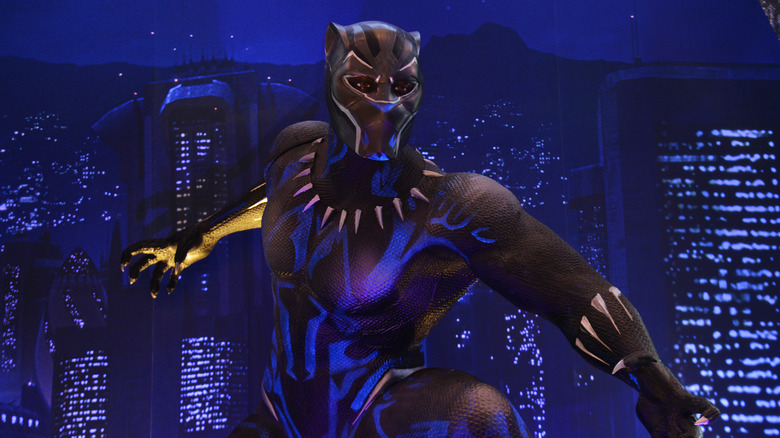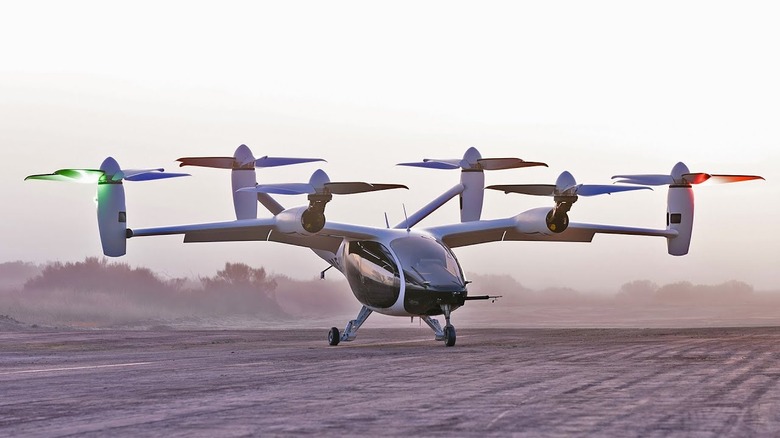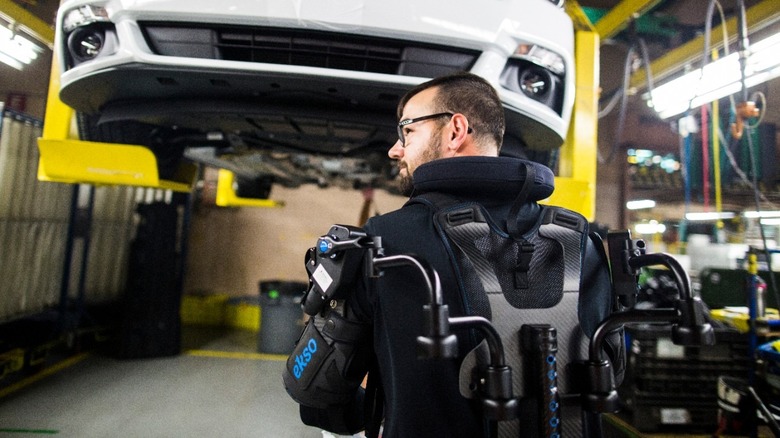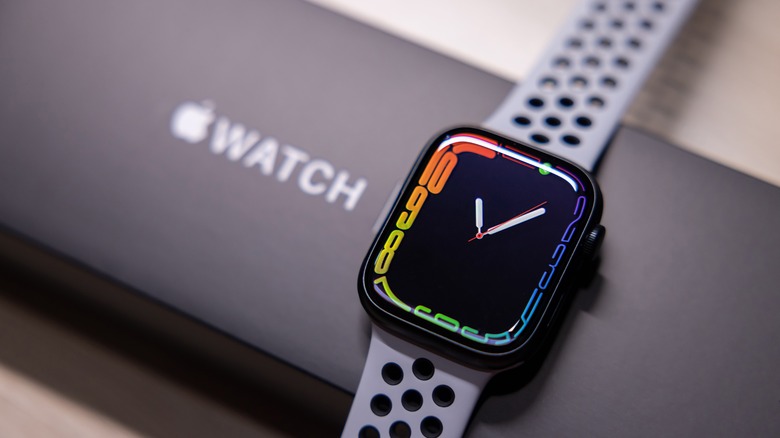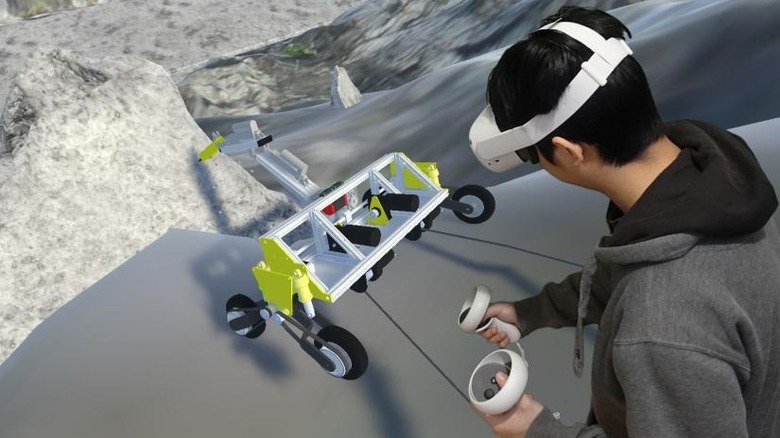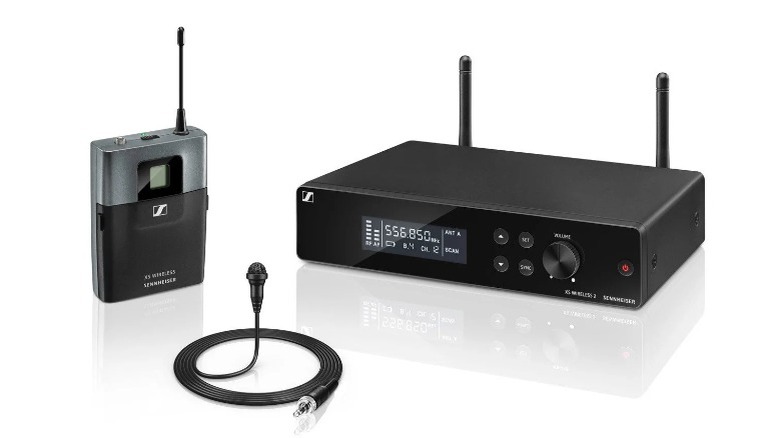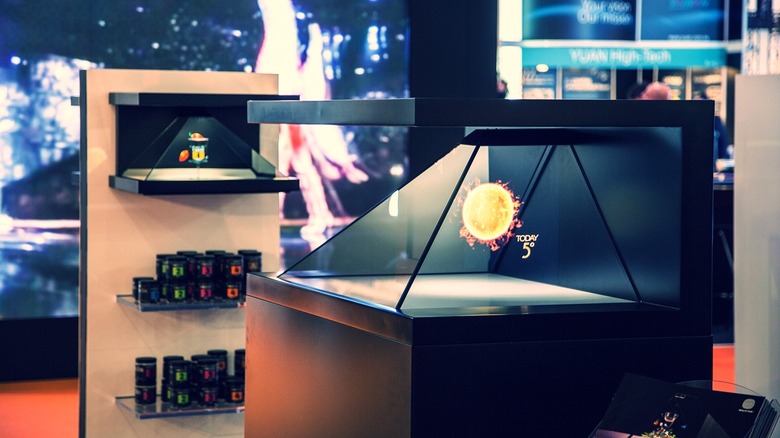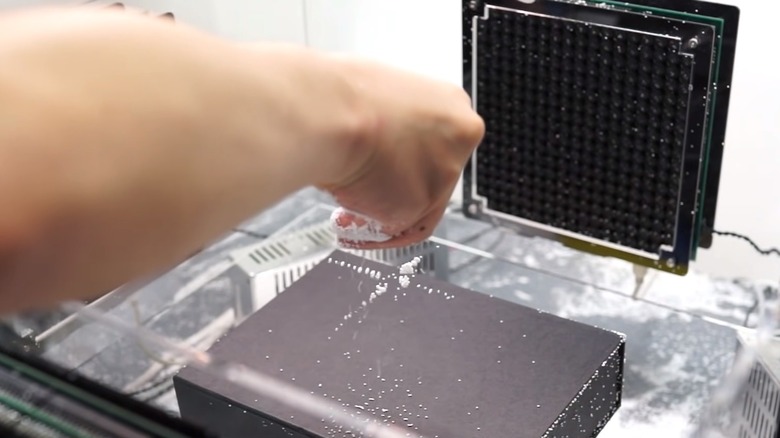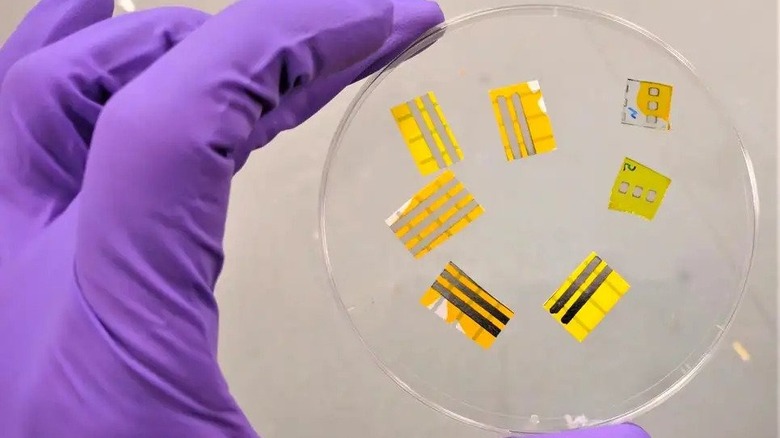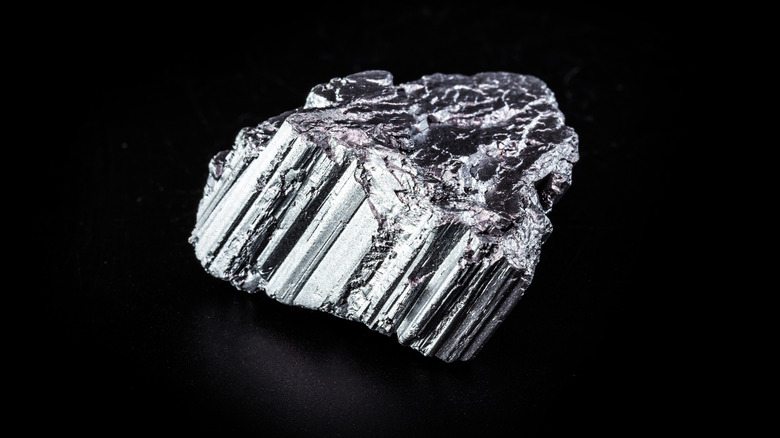Futuristic Black Panther Tech That's Closer Than You Realized
We may receive a commission on purchases made from links.
The nation of Wakanda in the "Black Panther" movie series is one of the most technologically advanced in the world, with many of these technologies powered by the rare element vibranium. It's unlike anything else seen in the Marvel Cinematic Universe, with the film's creators working with a leading VFX company to ensure every gadget fitted seamlessly into the fictional tech ecosystem. While much of this tech might seem a long way from reality, a lot of it is actually grounded in real-world research and isn't quite as far away as many might assume.
From futuristic levitating trains that actually made their commercial debut in a British airport in the '80s, to luminescent tattoos that scientists invented in reality in 2021, many of Wakanda's greatest tech creations also exist in the real world in some form or another. Even those that don't may be brought to the market within a few years, as developers take existing cutting-edge technologies and adapt them for new uses.
Levitating trains
Wakanda's "floating" maglev trains allow the kingdom to transport people and goods around much more efficiently than a regular train, as there's no friction between the train and the surface it travels on. Instead, powerful magnets are used to repel the train a centimeter or two off the ground, then by switching the polarity of these magnets, the train can be propelled along the track at great speed. While real-world maglev trains are a lot less efficient than the ones in Wakanda, they've been in commercial use for decades, with the first system opening at Birmingham Airport in the UK in 1984, according to Simple Flying.
Birmingham's maglev train was shut down in 1995 due to reliability issues and was replaced with a more conventional cable-hauled system, but there are a handful of other maglev systems still operational today. They're all in China, Japan, or South Korea, with several of them opening within the last 10 years. At the time of writing, there are no plans to integrate this innovative tech back into Western transport systems, but with Chinese researchers unveiling a prototype maglev that aims to become the fastest passenger train in the world, that might change in the future.
Self-piloting aircraft
The "Black Panther" series features a number of autonomous aircraft, with CIA agent Everett Ross able to remotely pilot an aircraft from Shuri's laboratory in 2018's "Black Panther." While this technology isn't commercially available in the real world yet, the National Air and Space Museum's curator Roger Connor explains that the tech isn't as far-fetched as it might initially sound. Uber's Elevate division has been pioneering self-flying electric aircraft for a few years now and recently merged with Joby Aviation, which boasts over $100 million of backing from the likes of Toyota and JetBlue (via Seeking Alpha).
The main issue with aircraft like these is battery weight, as the current crop of self-flying craft is only able to transport a few people at once. To increase that number to something commercially viable, the aircraft's batteries must become much more efficient than at present. Unfortunately, real-world scientists don't have access to any material as revolutionary as vibranium, but research is currently ongoing on both new battery materials and more efficient ways to package charge-holding parts of the battery. Even so, it seems autonomous aircraft are a fair way off from hitting the markets, but considering how far battery tech has already come in the past couple of decades, they're not out of the question.
Strength-enhancing suit
T'Challa's flexible, bulletproof, and energy-storing suit might be very much the realm of science fiction rather than reality, but individual elements of the suit already exist to some degree. LiveScience compares the suit's ability to give the wearer extra strength and agility to current exoskeletons, which can help users pick up heavy objects or even restore the ability to walk to those who can no longer do so on their own. For example, Hyundai's 2016 H-MEX exoskeleton provides renewed mobility to users who have lost partial or total use of their legs, allowing them to walk, turn, sit down, and climb stairs at a speed of up to 1.5 mph.
Not as fast as an able-bodied person, granted, but the exoskeleton that SlashGear tested was an early prototype. Ford has also developed its own exoskeleton to help its factory workers lift objects over their heads on longer shifts, with the skeleton preventing fatigue and reducing the chance of injury. The suit was first rolled out to the production line in 2018 and was such a success, Ford made the commitment to expand its use across its international production plants over the following years. While there's no real-life wraparound suit that can keep up with the might of T'Challa's, exoskeleton tech is already a reality, and it might well become more commonplace soon.
T'Challa's suit biosensors
Another aspect of T'Challa's suit that's already well on its way into the mainstream is its biosensors, which can monitor information like heart rate and various other bodily functions. Many leading smart wearables like the Apple Watch also let users check their heart rate in an instant, and can send alerts if a user's heart rate becomes irregular or dips below a specified minimum. The new Series 7 Apple Watch also offers a comprehensive suite of sleep-monitoring tools, and there's a blood oxygen saturation monitor which can help users track their overall wellness, says Apple.
Add that to the various fitness tracking sensors that are also available in fitness bands like FitBit, and you could argue it's never been easier to monitor exactly what your body's doing at any given time. The rise of office-based and other low-activity jobs has created a booming fitness and health market, so it's very likely that further advanced health-monitoring wearables will make their way to shelves in the near future.
VR-controlled cars
In one memorable scene from 2018's "Black Panther," Shuri pilots a car during a high-stakes chase through Singapore, but does so entirely remotely from her lab in Wakanda. This wouldn't be feasible in real life, as calculations by Sci-Fi Interfaces suggest that even if the signal traveled at the speed of light from continental Africa to Singapore, it would still take around 600 milliseconds round trip. Factor in things like processing and Shuri's reaction time, and it's unlikely she would be able to control the car precisely enough to drive with the accuracy that she does in the film.
However, most situations where a VR-controlled vehicle would be useful in real life won't require signals to travel across continents, but rather a mere few miles. This is where the idea becomes a lot more realistic, and there are several ongoing studies exploring the idea of VR-driven vehicles in the mining industry, in particular. One study in 2017 demonstrated how VR could be used to pilot rescue vehicles in a collapsed coal mine, with the robot able to traverse through the mine to look for survivors in need of rescue while the driver remained at surface level. Robotic vehicles could also eventually take the place of miners themselves, with researchers at the University of Technology Sydney unveiling a VR-driven prototype in 2020 (pictured above). While cross-continental VR-driven cars are likely to remain only possible in the MCU, VR-powered rescue or exploration vehicles remain very much on the cards.
T'Challa's listening devices
To listen in on FBI interrogations, T'Challa used tiny listening devices in 2018's Black Panther that were almost invisible to the naked eye. Wire-tapping is nothing new, but it's been suggested that the closest piece of real-life tech to that used in Wakanda is Sennheiser's Lavalier microphones, which provide broadcast-level sound in a hard-to-see package. The Sennheiser microphones come with wireless bodypacks that can broadcast sound to a receiver up to 330 feet (100 meters) away, and can run for up to 8 hours on one charge. The biggest downside to existing broadcast microphones is that their wireless functionality requires a relatively bulky transmitter that might prove difficult to hide in situations where full stealth was needed, but this limitation could be fairly easily solved in real life.
Integrating antennas and batteries into a jacket is a plausible solution, and similar technology is already on the market in the form of Google's Jacquard touch-sensitive fabric. The tech company teamed up with Levi's in 2015 to unveil an internet-connected denim jacket that can answer calls, control music playlists, or get directions. It felt like a regular denim jacket to wear, and it was fully washable, too, provided the wearer took out the smart tag first. Combining Google's Jacquard wearable tech with Sennheiser's level of microphone quality could make a smart wearable just as useful as the listening devices in Black Panther, and it would be stealthy enough to capture those all-important interrogation conversations, too.
Holographic video calls
Wakandans communicate with each other through wristbands that can project a 3D hologram of the person they're talking to into the air in front of them. One of the key changes brought about by the COVID-19 pandemic is that video calling is now more commonplace than ever, with both younger and older generations taking advantage of the technology to communicate with loved ones throughout lockdowns and social distancing mandates. Holographic technology is still some way off from becoming quite as mainstream, but recent tech unveiled by the likes of Looking Glass promises to make it easier than ever to create 3D images within a picture frame-sized viewer.
At present, all holographic tech requires some kind of transparent surface to function, so it's not possible to just project a hologram into the air like in Black Panther. However, the basic idea of holographic video calling is feasible, albeit within the realms of whatever viewing surface your choice of holographic technology can support.
Vibranium sand
Perception, the VFX company responsible for creating much of Black Panther's fictional tech, says the idea behind Wakanda's vibranium sand was inspired by "how primitive civilizations might communicate ideas quickly to each other, even before spoken language, by drawing in the dirt." Shape-shifting sand that can be arranged to temporarily form structures in an instant might not seem very realistic, but in fact, the team at Perception based the idea on the findings of a study from the University of Tokyo.
The researchers in Tokyo found that styrofoam particles could be manipulated with standing waves to form structures, and could even be held still in the air and moved around at will. While the technology is only replicable in lab conditions at present, it does confirm that the levitation and manipulation of small and lightweight items are possible, even if it's only in restricted circumstances. In theory, this technology could be transferred to more consumer-oriented uses, although it's safe to say that Wakanda-level shape-shifting sand is still much more fiction than fact.
Light-emitting tattoos
In order for Black Panther's suit to seamlessly form around the surface of his body, it was decided that some "guide rails" would be needed for the particles to flow along. The Perception team came up with the idea of using light-emitting sub-dermal tattoos as guide rails, with Black Panther's face being the most obvious place for these tattoos to be seen. The idea of a luminescent tattoo was still mostly science fiction when the first movie was released in 2018, however, three years later in 2021, a team of researchers from the Italian Institute of Technology and University College London unveiled OLED polymers that could be printed onto the skin like a child's temporary tattoo.
Previous attempts at LED "tattoos" were essentially implants that required surgery to take out once their batteries died, but the new OLED polymers simply degraded over time without the need for any invasive procedures. As well as the implications for tattoo art, the researchers envisioned a range of medical uses for the tattoos, including easily visible warnings to monitor an athlete or patient's hydration level, or replacing the permanently tattooed dots that cancer patients undergoing radiation therapy have to get applied. However, the biggest issue at present is that these OLED tattoos require an external power source to function, so it's unlikely that we'll see them offered in tattoo parlors any time soon.
A rare, powerful material like vibranium
All of Wakanda's futuristic technology relies on one material to function: vibranium. It's rare, expensive, and found almost exclusively in Wakanda, allowing the country to make technological advances that other nations simply don't have the resources to create. While it's unlikely that one single element could be discovered in reality with this much revolutionary potential, many of the REEs (Rare Earth Elements) used to create present-day technology are also found in just one or two countries. Neodymium, for example, is a vital component in making industrial-grade magnets, and it's used in everything from smartphones and headphones to electric vehicle motors. China controls over 80% of the world's supply, with 15% coming from Australia and only around 5% mined from the rest of the world.
The situation is much the same for the other rare earths, with China and a handful of other countries like Vietnam and Russia holding the vast majority of the world's deposits (via Investment Monitor). While current consumer technology is a long way off Wakanda's, it's hard to imagine the level of disruption that could be caused should China choose to stop exporting its rare earths to the rest of the world. And who knows, perhaps there's still a revolutionary rare earth element out there that we haven't even discovered yet.
